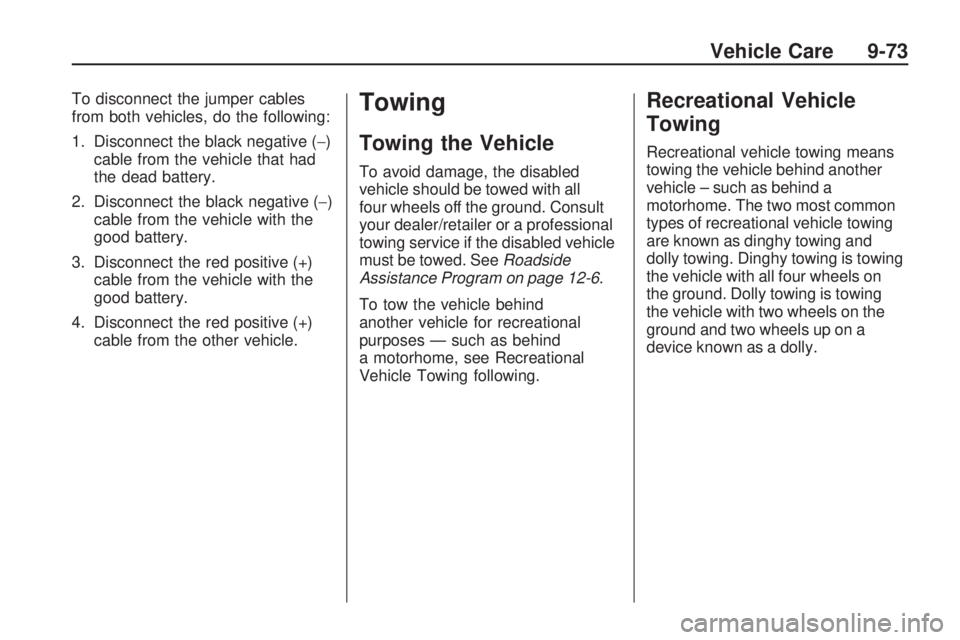Page 255 of 318

5. Check that the jumper cablesdo not have loose or missing
insulation. If they do, you could
get a shock. The vehicles could
be damaged too.
Before you connect the cables,
here are some basic things you
should know. Positive (+) will go
to positive (+) or to a remote
positive (+) terminal if the vehicle
has one. Negative (−) will go to a
heavy, unpainted metal engine
part or to a remote negative (−)
terminal if the vehicle has one.
Do not connect positive (+) to
negative (−) or you will get a short
that would damage the battery
and maybe other parts too. And
do not connect the negative ( −)
cable to the negative (−) terminal
on the dead battery because this
can cause sparks. 6. Connect the red positive (+)
cable to the positive (+) terminal
of the dead battery. Use a remote
positive (+) terminal if the vehicle
has one.
7. Do not let the other end touch metal. Connect it to the
positive (+) terminal of the good
battery. Use a remote positive (+)
terminal if the vehicle has one. 8. To access the remote negative
on the 1.8L engine, the cover will
need to be removed. To remove
the engine cover raise the rear of
the engine cover to remove the
rear clips and the front of the
engine cover to remove the
two front clips
1.8 L4 Engine
Vehicle Care 9-71
Page 256 of 318

Now connect the black
negative (−) cable to the negative
terminal of the good battery.
Use a remote negative (−)
terminal if the vehicle has one.
Do not let the other end touch
anything until the next step.
The other end of the negative ( −)
cable does not go to the dead
battery. It goes to a heavy,
unpainted metal engine part or to
a remote negative (−) terminal on
the vehicle with the dead battery. 9. Connect the other end of the
negative (−) cable at least
18 inches (45 cm) away from the
dead battery, but not near engine
parts that move. The electrical
connection is just as good there,
and the chance of sparks getting
back to the battery is much less.
10. Now start the vehicle with the good battery and run
the engine for a while.
11. Try to start the vehicle that had the dead battery. If it will not
start after a few tries, it probably
needs service.
Notice: If the jumper cables
are connected or removed in the
wrong order, electrical shorting
may occur and damage the
vehicle. The repairs would not be
covered by the vehicle warranty.
Always connect and remove the
jumper cables in the correct order,
making sure that the cables do not
touch each other or other metal. A. Heavy, Unpainted Metal
Engine Part
B. Good Battery
C. Dead Battery
2.4L L4 Engine
Jumper Cable Removal
9-72 Vehicle Care
Page 257 of 318

To disconnect the jumper cables
from both vehicles, do the following:
1. Disconnect the black negative (−)
cable from the vehicle that had
the dead battery.
2. Disconnect the black negative ( −)
cable from the vehicle with the
good battery.
3. Disconnect the red positive (+) cable from the vehicle with the
good battery.
4. Disconnect the red positive (+) cable from the other vehicle.Towing
Towing the Vehicle
To avoid damage, the disabled
vehicle should be towed with all
four wheels off the ground. Consult
your dealer/retailer or a professional
towing service if the disabled vehicle
must be towed. See Roadside
Assistance Program on page 12-6 .
To tow the vehicle behind
another vehicle for recreational
purposes — such as behind
a motorhome, see Recreational
Vehicle Towing following.
Recreational Vehicle
Towing
Recreational vehicle towing means
towing the vehicle behind another
vehicle – such as behind a
motorhome. The two most common
types of recreational vehicle towing
are known as dinghy towing and
dolly towing. Dinghy towing is towing
the vehicle with all four wheels on
the ground. Dolly towing is towing
the vehicle with two wheels on the
ground and two wheels up on a
device known as a dolly.
Vehicle Care 9-73
Page 299 of 318

•Flat Tire Change:Service is
provided to change a flat tire
with the spare tire. The spare tire,
if equipped, must be in good
condition and properly inflated.
It is the owner’s responsibility for
the repair or replacement of the
tire if it is not covered by the
warranty.
•Battery Jump Start: Service is
provided to jump start a dead
battery.
Services Not Included in
Roadside Assistance
•
Impound towing caused by
violation of any laws.
•Legal fines.
•Mounting, dismounting or
changing of snow tires, chains,
or other traction devices.
•Towing or services for vehicles
driven on a non-public road or
highway.
Services Speci�c to Canadian
Purchased Vehicles•
Fuel delivery: Reimbursement
is approximately $5 Canadian.
Diesel fuel delivery may be
restricted. Propane and other
fuels are not provided through
this service.
•Lock-Out Service: Vehicle
registration is required.
•Trip Routing Service: Detailed
maps of North America are
provided when requested either
with the most direct route or
the most scenic route. There is
a limit of six requests per year.
Additional travel information is
also available. Allow three weeks
for delivery.
•Trip Interruption Bene�ts
and Assistance: Must be over
250 Kilometres from where your
trip was started to qualify. General
Motors of Canada Limited
requires pre-authorization,
original detailed receipts, and a
copy of the repair order. Once
authorization has been received,
the Roadside Assistance advisor
will help you make arrangements
and explain how to receive
payment.
•Alternative Service:
If assistance cannot be provided
right away, the Roadside
Assistance advisor may give you
permission to get local emergency
road service. You will receive
payment, up to $100, after
sending the original receipt to
Roadside Assistance. Mechanical
failures may be covered, however
any cost for parts and labor for
repairs not covered by the
warranty are the owner
responsibility.
Customer Information 12-7